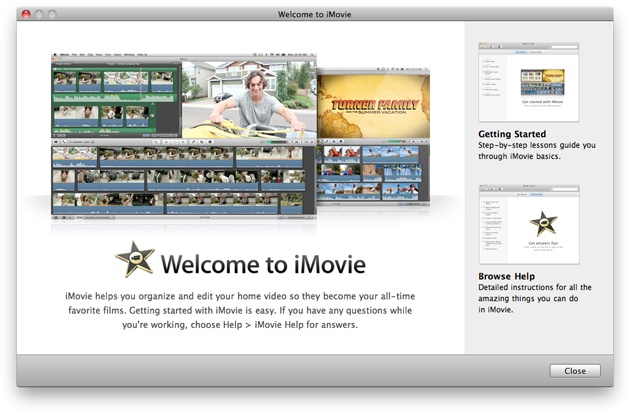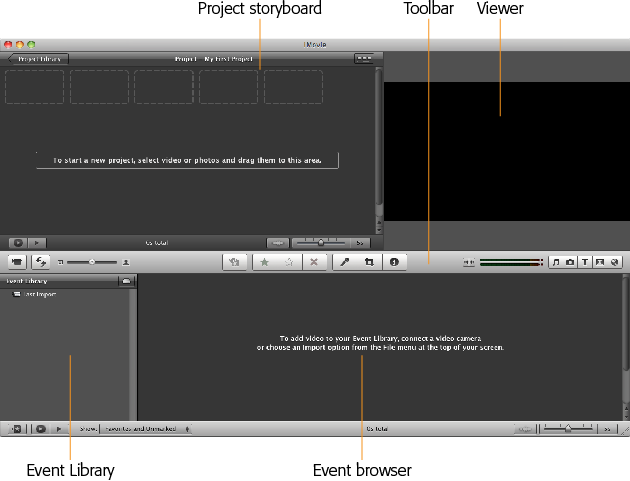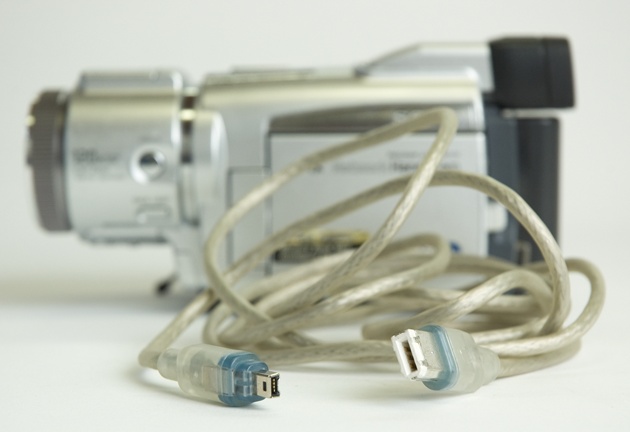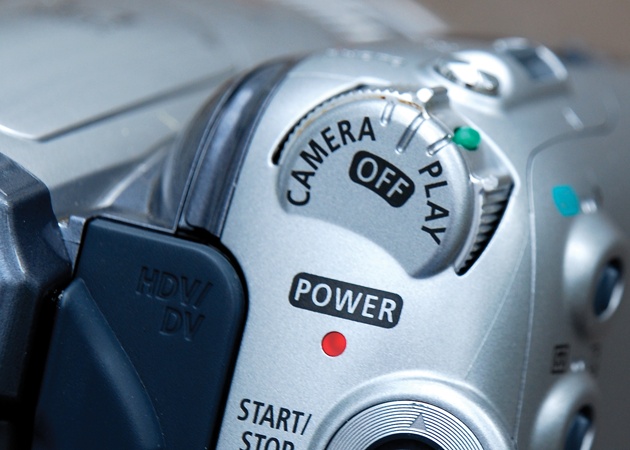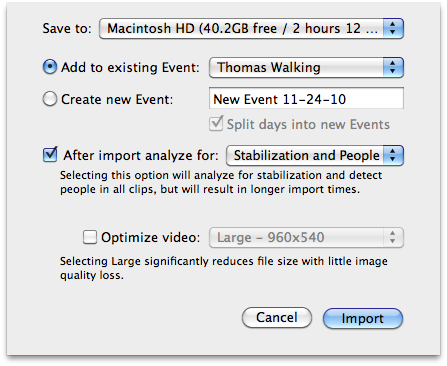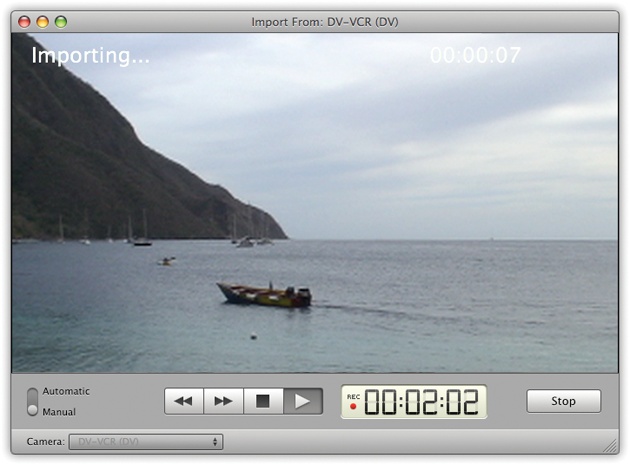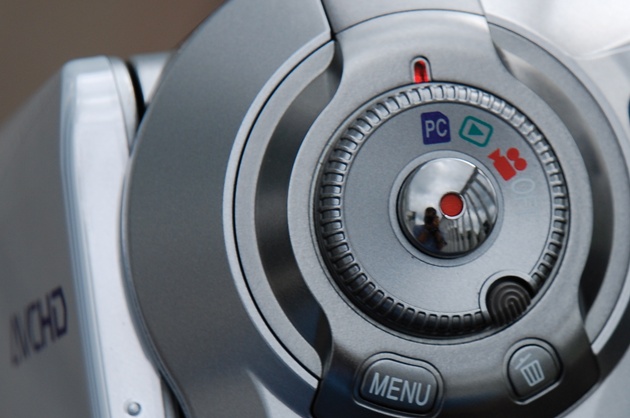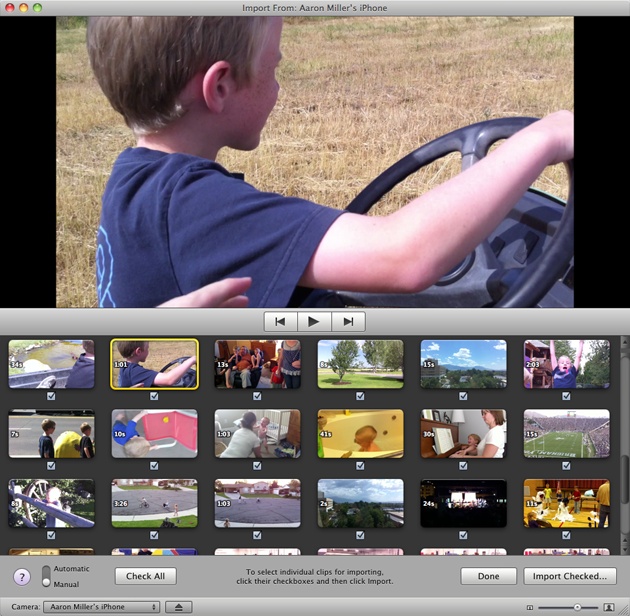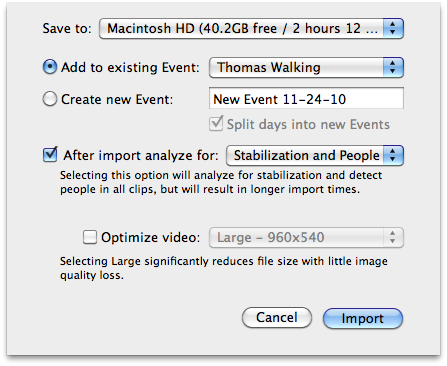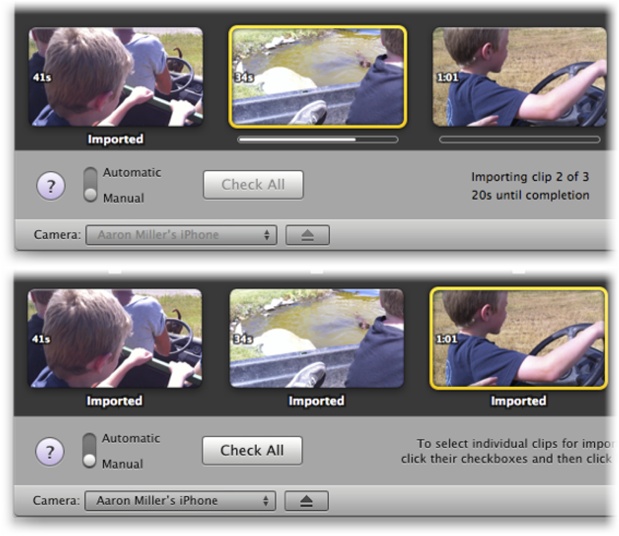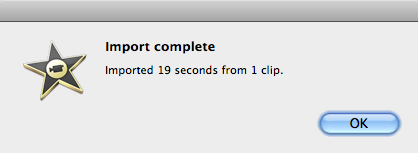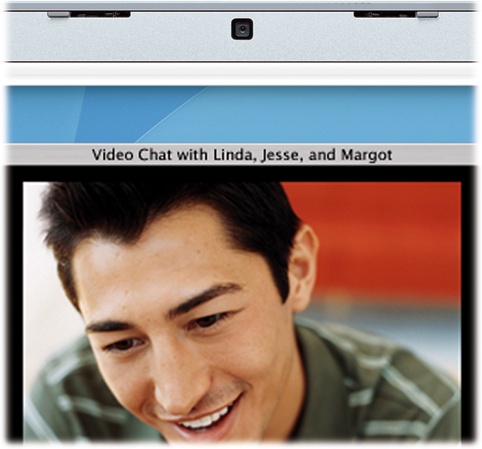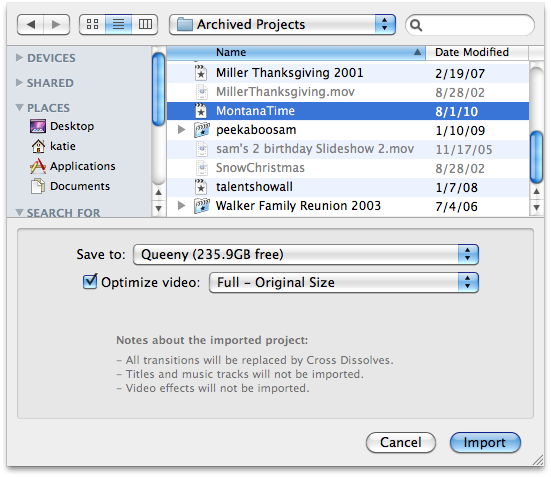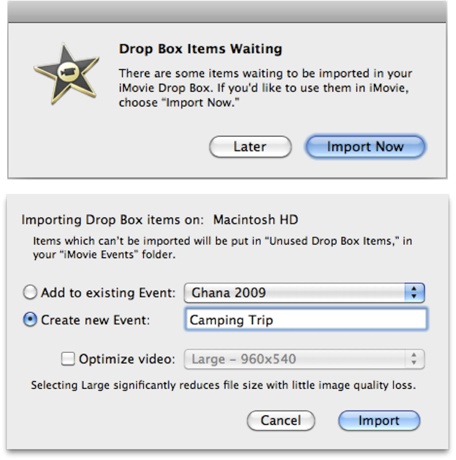Chapter 1. Importing Video
Let’s say you’ve filmed something. You’ve captured some video on your camcorder, digital camera, phone, or Flip, or maybe you’ve just assembled some videos on your hard drive. Now it’s time for the heart of this book: editing your footage using iMovie on the Mac. This chapter introduces you to iMovie and its importing window, which slurps up video from tape camcorders, tapeless camcorders, and old iMovie projects. It can also record video live, in real time, from a camcorder or an iSight video camera.
iMovie: The Application
So far in your moviemaking adventures, you’ve probably thought about nothing but hardware—the equipment needed to edit your raw footage. In the end, however, the iMovie story is about software, both the footage as it exists on your Mac and the iMovie program itself.
iMovie on a New Mac
If you bought a Mac after October 2010, iMovie ’11 is probably
already installed on your hard drive. To see, open the Macintosh HD
icon→Applications folder. Inside, you’ll find the star-shaped icon
for iMovie itself (![]() ). That icon is probably in your Dock,
too.
). That icon is probably in your Dock,
too.
iMovie for an Existing Mac
If your Mac didn’t come with iMovie ’11, you can buy it as part of Apple’s $50 iLife ’11 software suite. The suite comes on a single DVD and includes the latest versions of GarageBand, iMovie, iPhoto, iWeb, and iDVD. (It’s available from Apple’s website, Apple stores, Amazon.com, or popular Mac mail-order sites like www.macmall.com and www.macwarehouse.com.)
Apple says that iMovie requires an Intel-based Mac running Mac OS X version 10.6.3 or later. Apple also requires a machine with at least 1 gigabyte of memory. It goes without saying, of course, that the more memory you have, the bigger your screen, and the faster your processor, the happier you and iMovie will be. This program is seriously hungry for horsepower.
If you bought iLife, run its installer now and choose which of the programs listed above you want to install.
Tip
Consider installing GarageBand even if you’re not a musician. You may use it to assist iMovie with things like editing sound.
When the installer finishes up, you’ll find an icon called iMovie in your Applications folder and in your Dock.
Note
If you’ve got iMovie ’08 or ‘09 on your Mac already, the ’11 version replaces it. If you have iMovie HD (also known as iMovie 6), the installer thoughtfully preserves it (to find out why, see Parallel cutting). You’ll find a folder called “iMovie (previous version)” in your Applications folder, ready to run when necessary.
“.0.1” Updates
Like any other software company, Apple occasionally releases new versions of iMovie: version 9.1, version 9.2, and so on (or even 9.1.1, then 9.1.2, and so on). Each free upgrade improves the program’s reliability. They’re well worth installing for any program, but they’re especially important for iMovie; Apple does more than squash bugs with these updates, it often adds features you’ll want to use.
You don’t have to look far to find these updates. One day you’ll be online and the Mac’s Software Update dialog box will pop up onscreen, letting you know there’s a new version available and offering to install it for you. Alternatively, you can download any updates from within iMovie by choosing iMovie→Check for Updates.
When the updater finishes, your original copy of iMovie ’11 has morphed into the newer version of the program. (One way to find out what version of iMovie you have is to open the program and then choose iMovie→About iMovie.)
This book assumes that you have at least iMovie 9.0.
Getting into iMovie
After you install iMovie, open it by double-clicking its icon in
the Applications folder, or by single-clicking the star-shaped icon in
the Dock (![]() ).
).
Now, just in case you had somehow forgotten that iMovie is a totally new program, a special starter screen appears to let you know (Figure 1).
When you click Close, you arrive at the main iMovie screen. Figure 2 is a cheat sheet for iMovie’s various screen elements, but don’t spend time memorizing their functions now; the rest of this book covers each tool in context and in depth:
Project Library. If you’re used to the old iMovie, the new iMovie’s way of doing things may come as a shock. You create new movie projects the same way as always, by choosing File→New Project (or pressing ⌘-N). But now, after you type in a name for the movie you’re about to create, iMovie doesn’t ask where you want to save it. Instead, it adds your project’s name to this Project Library list, alongside all your other projects, past and present. More on projects in the next chapter.
Project storyboard. You’ll spend most of your editing time in this window. Here’s where you see your movie represented as filmstrips—short sequences of representative frames from each clip you shot. Parallel colored strips indicate blocks of sound that play simultaneously.
Toolbar. Here’s where you’ll find most of iMovie’s onscreen controls.
Event Library. In iMovie ’11, all your raw footage is available to all your movie projects at all times. The Event Library lists all the video you’ve ever imported into iMovie, on all your hard drives. iMovie organizes the footage by event—Wedding, Vacation, Graduation, and so on. You’ll read much more about Events on All About Events, but for now, it’s enough to know that iMovie lists your Events here, organized into folders by year.
Event browser. This area stores your raw, unedited clips—“filmstrips” of footage and individual shots—that you’ll rearrange into a masterpiece of modern storytelling. It displays the contents of the Event you choose in the Event Library, so exactly what you see here changes.
Playhead. The playhead is like the little handle of a normal scroll bar. It shows exactly where you are in a piece of footage.
If you just opened iMovie for the first time, it probably looks pretty barren. But you’ll fix that.
Importing Footage from a Tape Camcorder
If you have a MiniDV tape camcorder, high-def or not, transferring your recordings to the Mac is straightforward. All you have to do is connect the two machines—your camcorder and Mac—with a cable.
To do that, you use a FireWire cable, and
it looks like the one in Figure 3. The big end of
the cable goes into the FireWire jack on the front, side, or back of
your Mac; it’s marked by a radioactive-looking ![]() symbol.
symbol.
Note
Unfortunately, not all Mac models have FireWire jacks anymore, or they use a newer jack called FireWire 800. If your Mac has a FireWire 800 jack, you can find a cable that works with your camera (do a Google search or check the manufacturer’s accessories web page). The MacBook Air and the regular aluminum MacBook, though, lack any FireWire jack. If you have MiniDV tapes full of recorded video, you’re out of luck: There’s no adapter box or converter that connects your camcorder’s FireWire jack to a Mac that doesn’t have this jack. Your best bet is to borrow a Mac that has a FireWire jack, dump all of your tapes onto it, and then sell your old camcorder.
On the other end is a much smaller, squarish plug (called the four-pin connector). Plug this tiny end into the FireWire connector on your camcorder, which, depending on the brand, may be labeled FireWire, i.Link, or IEEE 1394. It’s almost always hidden behind a plastic or rubber door or flap on the camcorder.
This single FireWire cable communicates both sound and video from camcorder to Mac. Once you connect the cable, proceed like this:
Turn on the camcorder. Switch it into Play mode (Figure 4).
The camcorder’s playback mode may be labeled Play, VCR, VTR, or just
 .
.At this point, iMovie’s big blue Import window should open automatically. If it doesn’t, run through the troubleshooting checks described on Starting Up and Importing.
Specify what you want to import.
If you want to import the whole tape, make sure the Automatic/Manual switch (in the lower left of the Import From window) is on Automatic, and then click Import. This is a convenient feature, since you can walk away and do other things while iMovie works. Once iMovie finishes importing your footage, it displays a “Save to” dialog box (Figure 5); skip to step 3.
If you want to import only some of what’s on your camcorder, set the Automatic/Manual switch to Manual. At this point, iMovie’s Import window sprouts a set of playback controls (Figure 1-6). Use them to control your camcorder as it scans the tape to find the sections you want to include in your movie.
Figure 1-5. This dialog box wants to know: Where do you want to save the incoming clips (on which hard drive)? What Event do they belong to? Do you want iMovie to stabilize your jerky camera work (page 176) and/or scan your footage for people? And at what resolution should iMovie import your clips (which also, of course, affects how much hard drive space your footage takes up)?Figure 1-6. There are no keyboard shortcuts for the playback buttons on the Import From screen. Use your mouse to operate the camcorder from iMovie, or use the playback controls on the camcorder itself.Tip
You have to keep the mouse button down on the
 and
and  buttons continuously to make them work.
If you use these buttons while the video is playing, you scan
through the video; if you click Stop
buttons continuously to make them work.
If you use these buttons while the video is playing, you scan
through the video; if you click Stop  first, these buttons zoom much faster
through the tape, but of course you can’t see where you are
until you hit
first, these buttons zoom much faster
through the tape, but of course you can’t see where you are
until you hit  again.
again.When you find a shot worth bringing onto your Mac, click the Import button at the lower-right corner of the window. The “Save to” dialog box appears (Figure 5); read on.
Tell iMovie where you want it to save the imported clips.
Most people, most of the time, save incoming video to their main Mac hard drive. But true iMovie addicts wind up buying additional hard drives to hold their movies. That’s why the “Save to” pop-up menu appears here—so you can choose the hard drive you want to hold your video.
Specify an Event.
The pair of choices shown in Figure 5 let you answer these questions: Were the scenes you’re about to import filmed at a new Event? Or should iMovie file them along with scenes you already imported—as part of an existing Event, in other words?
Selecting the right option, of course, requires that you know what Apple means by an Event. See The Definition of an Event on page 39.
Turn on “Analyze for stabilization and/or people,” if you’ve got the time.
iMovie’s built-in footage stabilizer is one of its most important and most effective features. It converts unsteady video into footage that looks as though the camera were on a tripod.
The people analyzer scans all your footage for human faces, and then tags clips that include close-up, medium, and wide shots with people in them, as well as shots that include one, two, or more people. This way, you can go straight to footage that has people in it rather than wade through the junk footage of your foot, shot when you forgot to stop recording.
The downside of these miraculous options is that your Mac requires a long period of thoughtful analysis before it can stabilize or people-find. It literally studies the first frame of video, compares each pixel to what’s on the second frame, and so on. That takes a long time—hours, in some cases. (If you just analyze for people and not for stabilization, the process takes iMovie about one-tenth as long.)
Fortunately, you can always apply these two features to individual parts of a movie, which saves huge amounts of time. In other words, the only reason to analyze for stabilization and/or people at this stage is because you intend to let the Mac crunch away for half a day (or night) after it finishes importing your footage.
If you have a high-definition camcorder, optimize your video as either “Large – 960x540” pixels or “Full – 1920x1080” pixels.
This option appears only if you import video from a high-definition camcorder, one that captures 720p, 1080i, or 1080p footage. (These terms refer to the number of horizontal lines that make up each frame of video. The more lines, the crisper your video. The “p” in 720p and 1080p means that each frame of video contains a full set of video-signal lines. The “i” in 1080i stands for “interlaced.” That means that, instead of drawing each line of video from top to bottom one after the other, it splits the video signal into two sets of 540 lines each, one set odd and the other even. Your TV interlaces the odd and even lines, flashing them alternately on the screen.)
By giving you the Large and Full options, iMovie offers you the chance to import a smaller-scale version of that gigantic video canvas so you can save hard drive space. For assistance in making the Large vs. Full decision, see the box on Large vs. Full.
Click Import.
If you chose the Automatic option, iMovie rewinds the camcorder tape to the beginning, and then tells the camcorder to begin playback. As the video plays, iMovie captures it and stores it on your Mac. You can interrupt this process by clicking Stop if necessary; at this point, iMovie displays a little congratulations message, revealing how many minutes’ worth of video you imported. You can click OK and then import some more, if you like, by starting from step 2 above.
Or you can click the Import button and walk away while iMovie works. You can surf the Web, crunch numbers, organize pictures in iPhoto, or whatever you like. Since iMovie is a Mac OS X program, your Mac doesn’t have to devote every cycle of its processing power to capturing video. It continues to give priority to the video, so your other programs may act a little drugged. But you can get meaningful work done or read while iMovie works in the background.
If you let the Automatic import proceed without interruption, iMovie auto-rewinds the tape when it reaches the end.
If you chose the Manual setting, you can use iMovie’s playback controls to operate the tape, shuttling through it to find the parts you want; use the Import button (and its alter ego, the Stop button) to capture only the good parts.
Tip
When you come to a scene you want to bring into iMovie, capture 3 to 5 seconds of footage before and after the interesting part. Later, as you edit, that extra leading and trailing video (called trim handles by the pros) gives you the flexibility to choose exactly the right moment for the scene to begin and end. Furthermore, you need extra footage at the beginning and end of your clips if you want to use transitions like crossfades to take viewers from one scene to another.
Unfortunately, the import process isn’t the speedy joyride it was in the previous version of iMovie, where you could just tap the space bar (or click Import) every time you wanted to start or stop importing during playback.
In iMovie ’11, each time you click Stop, iMovie locks you out for a minute or two while it displays the Generating Thumbnails message. That’s iMovie’s way of saying, “I’m processing this video and making some live, ‘skimmable’ filmstrips” (described on Skimming).
Once that message disappears, you can use the playback controls to find the next bit of video worth importing—but you have to fill out the box shown in Figure 5 all over again, every time.
These frequent “Generating Thumbnails” and “Save to” interruptions are, for many people, a pretty strong argument for avoiding the Manual settings. The Automatic setting winds up saving you a lot of time—and doesn’t cost you any extra disk space (see Reclaiming Disk Space on page 41).
When you and iMovie are both finished, click Done.
The Import window goes away. You return to the iMovie screen, where you can click the name of the Event you specified in step 4 to see the newly imported clips. Proceed to Chapter 2.
Automatic Scene Detection
You’ll notice a handy feature when iMovie finishes importing footage: The program automatically creates an individual filmstrip (clip) for each scene you shot. So an hour’s worth of tape doesn’t wind up as a single, mega-chunk of video—instead, you wind up with 30 or 40 individual clips, just the way you shot them.
You get these separate chunks of video because, behind the scenes, iMovie studies the date and time stamp that digital camcorders record with every frame of video. When iMovie detects a break in time, it assumes that you stopped recording, if only for a moment, and therefore considers the next piece of footage a new shot. It turns each new shot into a new clip.
In general, this feature doesn’t work if you haven’t set your camcorder’s clock. Automatic scene detection also doesn’t work if you’re playing from a nondigital tape using one of the techniques described on Importing Footage from Old Analog Tapes.
Importing from Tapeless Camcorders
The beauty of tapeless camcorders is that, because they store video as computer files on a hard drive, a DVD, or a memory card, you don’t have to wait for the clips to play back in real time so iMovie can save them to your Mac. Instead, the importing process takes only as much time as iMovie needs to copy these files onto your Mac’s hard drive. (At least in theory; read on.)
Note
If your camcorder records onto miniature DVDs, see Importing from DVD Camcorders for some additional notes.
Once you’re ready to transfer video from your tapeless camcorder, here’s what to do:
Connect the camcorder’s USB cable to your Mac.
Most tapeless camcorders connect to the Mac using a USB cable, which comes with your camcorder (see Figure 1-7). It connects to any of the Mac’s skinny rectangular USB jacks. (If you have one of those tiny, very popular Flip camcorders, plug in its pop-out USB connector instead.)
Turn on the camcorder, and then switch it into PC mode.
The wording might vary, but every tapeless camcorder has a mode for making PC or Mac connections (Figure 1-8).
If everything is going well, a message appears at the top of the screen that says, “Generating Poster Images.” Then, after a minute, you see the Importing screen depicted in Figure 1-9.
Figure 1-8. Every camcorder has a switch or command that lets you connect it to a PC (or, in this case, a Mac). Most tapeless camcorders have a dedicated position on the main mode dial for this purpose, like the camera above.Figure 1-9. You can import individual scenes from a tapeless camcorder without having to rewind or fast-forward through footage. You can also preview the recorded scenes before you bother importing them (see step 3 below). If your intention is to bring in most of the clips, turn off the checkboxes under the scenes you don’t want. If you want to import fewer than half of them, though, click Uncheck All, and then turn the checkboxes back on for the shots you do want.If iMovie doesn’t open, or if the Importing screen doesn’t appear, then choose File→Import From Camera, or run through the troubleshooting steps described on Starting Up and Importing.
You’re about to experience one huge payoff of using a tapeless camcorder: instant access to individual scenes on the camcorder. That means, first of all, that you don’t have to rewind or fast-forward to find a certain shot. Furthermore, as you can see in Figure 1-9, iMovie lets you import only the shots you want, leaving the duds behind. That feature alone can represent a huge time savings over the old “import the whole tape” method.
Tip
If your camcorder stores video on memory cards—SD cards, for example—you have another option at this juncture. You can remove the card from the camcorder and insert it into a card reader (which may even be built into your Mac laptop). The advantage of the card-reader method is that you don’t use up the camcorder’s battery power as you transfer your video.
Review your shots before you import them.
To play a shot, click its thumbnail and then click the
 button. Click the
button. Click the  or
or  buttons to skip to the previous or next
shot on the camcorder (or just click the thumbnails on the screen
in front of you).
buttons to skip to the previous or next
shot on the camcorder (or just click the thumbnails on the screen
in front of you).Specify which shots you want to import.
If you want to import everything on the camcorder, click Import All and then skip to step 5.
If you want to import only some of the shots, move the Automatic/Manual switch in the lower-left corner of the Import window to Manual. You’ll see little checkboxes under the shot thumbnails. All of them start out with checkboxes turned on, meaning that iMovie intends to import all of them. See Figure 1-9 for tips on selecting just the scenes you want. Once you specify your shots, click Import Checked.
At this point, the top of the window displays a little sheet of options (see Figure 1-10).
Tell iMovie where you want to save your imported clips.
Most people save incoming clips to their main Mac hard drive. But if you bought additional drives specifically for your movie files, use the “Save to” pop-up menu to choose a different drive.
Specify an Event.
The pair of choices shown in Figure 1-10 lets you answer these questions: Are the scenes you’re importing part of a new Event, or should iMovie file them with scenes you already imported, as part of an existing Event? See The Definition of an Event on page 39 for suggestions on what to choose here.
If you have a high-def camcorder, optimize your video as either “Large – 960x540” or “Full – 1920x1080 ”.
You may not see the final option shown in Figure 1-10. It appears only when you import video from a high-definition camcorder, one that captures 720p, 1080i, or 1080p video. See Large vs. Full on page 37 for a discussion of this option and advice on what to choose.
Analyze for stabilization and/or people, if you’ve got the time.
iMovie’s built-in footage stabilizer is one of its most important, and most effective, features. It converts unsteady video into footage that looks as though the camera were on a tripod. The people finder tags clips containing faces, making them easier to find later. But this “analysis” can take hours. See step 5 on Importing Footage from a Tape Camcorder for help in making this decision.
Click Import.
Now iMovie swings into action. It begins slurping in video from the camcorder’s hard drive, DVD, or memory card. As it works, a progress counter ticks off the remaining shots left to import (Figure 1-11).
Considering that a tapeless camcorder is supposed to spare you the agony of importing footage from tape in real time, you may be surprised at how long it actually takes to import clips from a tapeless camera. AVCHD footage in particular (AVCHD) takes a long time because iMovie has to convert it into an editable format; depending on the speed of your computer, you may wind up waiting 2.5 minutes for each minute of video. An hour’s worth of video, in other words, can take 2 and a half hours to import. You’ve been warned.
But never mind that; once iMovie is done, it displays a message to congratulate you. It lets you know how many minutes and seconds of video you imported in total, and how many clips you grabbed (Figure 1-12).
Figure 1-11. Top: The time readouts here not only tell you how much longer it’ll take to import a clip in “minutes:seconds” format, it also shows you how many clips iMovie still has to import. Bottom: When it’s all over, the word “Imported” appears under each thumbnail. That’s a handy reminder when you’ve opted to import only some of your clips.Click OK.
The congratulations message goes away.
Click
 to eject the camcorder, and then click
Done.
to eject the camcorder, and then click
Done.The Import screen goes away. You arrive at the main iMovie screen, where your new video appears in the Events list at the left side of the screen. All About Events describes this structure in more detail.
You can now turn off the camcorder to save battery power, if you like.
Importing from an iPhone, iPad, or iPod Touch
If you have an iPhone (iPhone 4 or later), iPad, or camera-equipped iPod Touch, you’ve probably been pulling it out of your pocket to shoot all kinds of great moments. Now you’d like to import those clips into iMovie to start editing.
In true, smooth Apple fashion, everything you read about importing video from tapeless cameras applies here. iMovie ’11 automatically recognizes your iPhone, iPad, or Touch, just as it does a regular tapeless camcorder. It also lets you select individual clips to import. iMovie even offers the same import options for analyzing and/or optimizing your footage.
The only real difference is that plugging in your iPhone, iPad, or iPod Touch still opens iTunes automatically and starts syncing, even if you only want to import clips into iMovie (a minor annoyance that you can turn off in iTunes if you really want to).
Importing from DVD Camcorders
In general, DVD camcorders are a mess. They’re fussy, they take a long time to “initialize” and “finalize” a blank DVD, each disc doesn’t hold very much footage, the recorded discs may not have a very long lifespan in your closet, and the miniature DVDs can actually damage your Mac.
If that’s what you’ve got, though, the routine for importing video from a DVD camcorder—at this writing, the most popular format on the market—is exactly the same as it is for other tapeless camcorders. The instructions begin on Automatic Scene Detection.
There are, however, a few caveats:
iMovie can’t import video from DVD camcorders that use the AVCHD video format (AVCHD). Unfortunately, that pretty much rules out all the high-definition DVD camcorders.
Thanks to the hostility of the engineers who dreamed up the DVD camcorder disc, most DVD camcorders offer multiple recording formats, with such cheerful names as DVD-Video and DVD-VR. Each has tradeoffs: One plays back in a broader range of DVD players, another lets you erase scenes before committing them to plastic, and so on.
The thing is, you have to choose which format you want when you put the blank DVD into the camcorder. That’s when the screen offers you the choice of formats. The key here is to choose the DVD-Video format, sometimes called Standard. If you choose VR or DVD-VR instead, iMovie won’t be able to import your recorded video. (When you connect the camcorder, iMovie thinks you just inserted a DVD, rather than thinking that you attached a disk full of video.)
Recording Live from a Camcorder or iSight Camera
iMovie is also happy to capture live video straight from a tape camera, sending whatever it “sees” directly into iMovie. You can perform this stunt in either of two ways:
Using an iSight camera. All recent Mac laptops and iMacs have this tiny Apple video camera built right in, just above the screen (Figure 1-13).
Using a camcorder. Alternatively, you can connect a MiniDV camcorder to your Mac and use it as a glorified eyeball. (This doesn’t work with tapeless and USB camcorders, and doesn’t work if your Mac lacks a FireWire jack [AVCHD Lite].)
If you’re using a camcorder, set its mode switch to Camera or Record (rather than VCR or Play, as you would if you were importing something you’d already recorded).
If you’re using an iSight camera or FireWire webcam, you can skip this step.
Choose File→Import from Camera (⌘-I), or click the camcorder-shaped button at the left side of the screen.
Either way, the Import window opens. If everything’s going your way, you’ll see a live video image from your camera.
Click Capture.
The usual “Save to” dialog box appears, just as shown in Figure 5.
From the “Save to” pop-up menu, choose a hard drive’s name.
Specify where you want iMovie to save your imported video.
Specify an Event.
The pair of choices shown in Figure 5 lets you answer these questions: Were the scenes you’re about to import filmed at a new Event, or should iMovie file them with scenes you already imported, as part of an existing Event? See The Definition of an Event on page 39 for details.
Click OK.
To end the recording, click Stop.
iMovie enters its usual “Generating Thumbnails” state of catatonia for a few minutes.
To record more video, repeat these steps, starting at step 2.
When you finish recording, click Done.
Your video appears in the Event you specified, ready for editing.
Importing Old iMovie Projects
Most software companies, most of the time, stick with certain time-honored traditions concerning software upgrades. One of them happens to be compatibility: If you release BeeKeeper Pro 7, it goes without saying that it can open files BeeKeeper Pro 6 created.
iMovie ’08, ’09, and ’11, though, aren’t updated versions of iMovie 6 (also known as iMovie HD); they’re versions 1.0, 2.0, and 3.0 of a completely different program, written from scratch (see The Difficult Birth of the New iMovie for details). Their ability to import older iMovie projects is extremely limited.
To bring in an older iMovie project, choose File→Import→iMovie HD Project. The dialog box shown in Figure 1-14 appears.
Here, you should make two decisions before choosing the old iMovie project you want to open:
Where do you want to save the imported, converted project? The “Save to” pop-up menu lists your hard drives and shows you how much space is available on each.
How do you want iMovie to handle high-definition video projects? See Importing from Tapeless Camcorders for details on making a choice here.
Once you make your choices, navigate to the iMovie project you want to import, and double-click its name or icon.
iMovie ’11 springs into action, importing the video clips (making a new copy of them) and generating the filmstrip thumbnails you’ll work with as you edit. This process can take a good long time.
When it’s all over, whatever clips you had in your old project’s iMovie timeline appear in the iMovie ’11 Project (storyboard) area, in the correct sequence, correctly trimmed. iMovie imports leftover clips, too—the ones left unused in the Clips pane of your old project. They show up in the Event that holds your project, just in case you want to add them to the project later.
On the other hand, iMovie brings in only a few basic elements of the original iMovie project. To be precise:
You get only the clips. iMovie ’11 ignores all effects, titles, and credits. (Ouch.)
You lose all the audio work you did. iMovie ’11 ignores everything in the old iMovie’s two audio tracks, including music, narration, sound effects, and any audio “paste-over” cutaways. The only audio that carries over is that in your project’s video clips.
iMovie replaces all your scene transitions. If you used any transitions in your old iMovie project, iMovie ’11 replaces them all with generic crossfade dissolves.
If you really, truly want to go to all this trouble, you can now start over again, repairing and reconstructing the movie, restoring the elements that got lost during the import process. You might find the effort worthwhile if you want to use some iMovie ’11 tools that weren’t available in the old iMovie, like video cropping, stabilization, rotation, or one-click exporting to YouTube.
Otherwise, though, consider leaving your old iMovie projects just as they are. As Chapter 12 makes clear, the old iMovie version is still perfectly usable and freely available to you, so it might make more sense to leave it in its original format.
Dragging Video In from the Finder
iMovie can import movies directly from your hard drive, too—no camcorder needed. Position the iMovie window so you can see your movie files in the Finder, and then drag the files’ icons directly onto an Event in iMovie’s Event list. (Each clip icon is different—iMovie creates the icon still from actual footage.)
Alternatively, use the File→Import→Movies command to find and select the movies you want to import. iMovie asks which Event you want to save the imported flicks to.
Either way, you wind up with your digital movie files in an Event and ready to edit.
Importing with iMovie’s Drop Box Folder
If you’re short on time and you have a stack of videos you want to import, iMovie ’11’s new Drop Box folder is your friend. iMovie will import any video files in this folder the next time you open the program. This way, you can simply drop your movie files into the folder and forget about them. Then, the next time you launch iMovie, it imports the files. And if you’re a pro with automation programs, like AppleScript or Automator, this folder becomes even handier (Automator and iDVD).
Look in your iMovie Events folder (Project Folders) to find the folder called iMovie Drop Box. After you add files to this folder, iMovie displays a message like the one in Figure 1-15 the next time you open the program. Click Import Now; iMovie displays an Import window much like the one you saw in Figure 5. (For some reason, this window is missing the Stabilization checkbox. You’ll have to analyze this footage later, as explained on Video Stabilization.)
Importing Footage from Old Analog Tapes
We live in a transitional period. Millions of the world’s existing camcorders and VCRs require VHS, VHS-C, or 8mm cassettes—that is, analog tapes instead of digital.
These days, people buy only digital camcorders. But in the meantime, how are you supposed to import and edit the footage you shot before the digital era? Fortunately, this is fairly easy to do if you have the right equipment. You can take any of these four approaches, listed roughly in order of preference.
Note
When you use any of the approaches below, iMovie won’t be able to chop the video into individual scenes automatically, as it does with digital video. That’s because old analog camcorders didn’t stamp every frame of every shot with an invisible time code, so iMovie doesn’t know when you started and stopped your camcorder.
Approach 1: Use a Camcorder with Pass-Through Conversion
If you’re in the market for a new digital camcorder, here’s a great idea: Buy a Sony or Canon MiniDV tape camcorder that has analog-to-digital pass-through conversion. The camcorder itself acts as a converter—it turns the signal from your old analog tapes into a digital one that you can edit in iMovie. (Unfortunately, few modern camcorders have this feature, so ask before you buy. And on some models, you have to use the camcorder’s own menu system to enable pass-through—and that process requires a Mac model that has a FireWire jack.)
Your old footage never hits a MiniDV tape. It simply plays from your older VCR or camcorder through the digital camcorder “converter” and into your Mac.
If you’ve got a drawer full of analog tapes, a pass-through camcorder is by far the most elegant and economical solution, especially if you’re shopping for a new camcorder anyway.
Approach 2: Record onto Your DV Camcorder
Even if your newish digital camcorder doesn’t offer real-time analog-to-digital conversion, it may have analog inputs that let you record your old material onto a MiniDV tape in your new camcorder. If so, your problem is solved:
Unplug the FireWire cable from the DV camcorder.
Most camcorders’ analog inputs automatically switch off if you have a FireWire cable hooked up.
Connect RCA cables from the Audio Output and Video Output jacks on the side of your older camcorder or VCR. Connect the opposite ends to the analog inputs of your DV camcorder.
Put a blank tape in your DV camcorder.
Tip
If both your old camcorder and your DV camcorder have S-video connectors (round, dime-sized jacks), use them instead. S-video connections offer higher-quality video than RCA connections. (Note that an S-video cable doesn’t conduct sound, however. You still have to connect the red and white RCA cables to carry the left and right stereo sound channels.)
Switch both camcorders into VTR or VCR mode.
You’re about to make a copy of the older tape by playing it into the camcorder.
By now, every fiber of your being may be screaming, “But analog copies make the quality deteriorate!” Relax. You’re only making a first-generation copy. Actually, since you’re making a digital copy, you lose only half as much quality as you would with a normal VCR-to-VCR duplicate. In other words, you probably won’t be able to spot any picture deterioration. And you’ll have the footage in digital format forever, ready to make as many copies as you want with no further quality degradation.
Press the Record button on the DV camcorder, and press Play on the older VCR or camcorder.
You can monitor your progress by watching your camcorder’s LCD screen. Remember that a DV cassette generally holds only 60 minutes of video, compared with 2 hours on many previous-format tapes. You may have to change DV cassettes halfway through the process.
When it finishes the transfer, you can rewind the newly recorded DV cassette in the DV camcorder and import it into iMovie exactly as described in this chapter.
Approach 3: Use a Media Converter
If your digital camcorder doesn’t have analog inputs, you can buy an analog-to-digital converter— a box that sits between your Mac and your VCR or older camcorder (Figure 1-16). It’s an unassuming half-pound gray box, about 3 x 5 inches. Its primary features include analog audio and video (and S-video) inputs, which accommodate your older video gear, and a FireWire jack, whose cable you can plug into your Mac.
You’ll be very pleased with the video quality. And when it comes to converting older footage, the media-converter approach has a distinct advantage over DV camcorders with analog inputs: You have to sit through the footage only once. As your old VCR or camcorder plays the tape through the converter, the Mac records it simultaneously. (Contrast that with Approach 2, which requires you to play the footage twice: once to the DV camcorder, and then from there to the Mac.)
Unfortunately, you can’t control these devices using iMovie’s playback controls, as described earlier in this chapter. Instead, you have to transfer your footage manually, by pressing Play on your old camcorder or VCR and then clicking Import on the iMovie screen. In that way, these converters aren’t as convenient as an actual DV or Digital8 camcorder.
Approach 4: Use a Digital8 Camcorder
Sony’s Digital8 family of camcorders accommodate 8mm, Hi-8, and Digital8 tapes, which are 8mm cassettes recorded digitally. (Low-end models may not offer this feature, however, so ask before you buy.) Just insert your old 8mm or Hi-8 cassettes into the camcorder and proceed as described in this chapter. iMovie never needs to know that the camcorder doesn’t contain a DV cassette.
Actually, a Digital8 camcorder grants you even more flexibility: Most Digital8 camcorders also have analog inputs, which let you import footage from your VCR or other tape formats, as described in Approach 2.
Get iMovie '11 & iDVD: The Missing Manual now with the O’Reilly learning platform.
O’Reilly members experience books, live events, courses curated by job role, and more from O’Reilly and nearly 200 top publishers.
